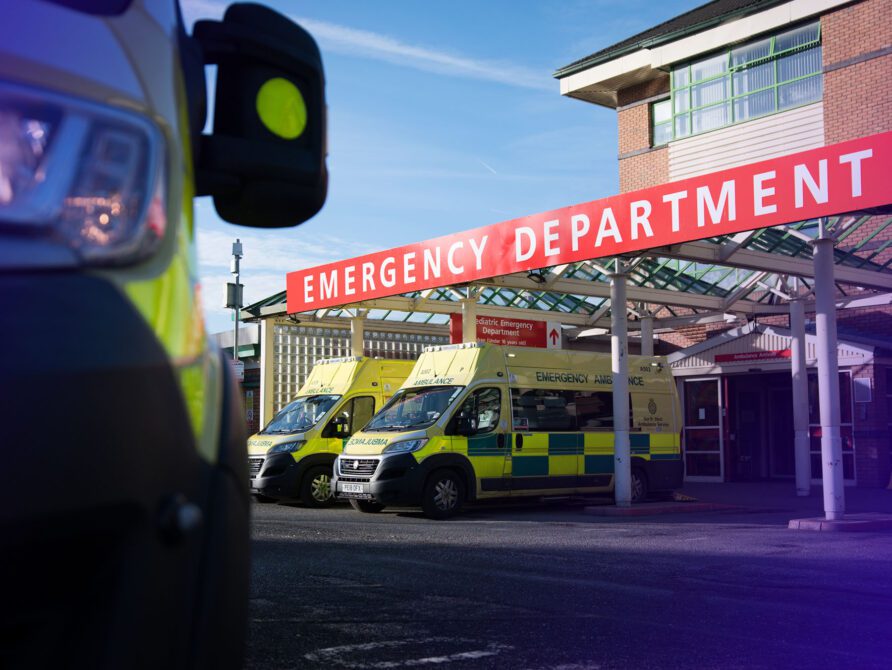INSIGHTS
Bolton NHS Foundation Trust (BFT), in collaboration with Greater Manchester Police and mental health services, embarked on a pioneering project to address the issue of unnecessary police callouts when patients went missing from emergency departments. The goal was to develop a digital solution that would support the national Right Care, Right Person initiative, ensuring patients receive the right care from the right service.
National recognition
Reduced pressure on emergency services
Reduced police callouts
Improved patient safety
Increased efficiency
Structured documentation is a must
Prior to the project, clinical teams at BFT would often contact police teams as a precaution when patients could not be located, even if the individual had simply chosen to leave the hospital. This lack of structured documentation and risk framework led to unnecessary referrals, placing a strain on police resources.
An innovative solution
Working closely with Altera Digital Health, the trust extended the use of Sunrise Electronic Patient Record (EPR) system, by co-designing a risk assessment and documentation tool within the EPR system. The innovative solution features a Red-Amber-Green (RAG) algorithm that guides clinicians through key checks, supports professional judgement and ensures referrals to police are based on shared criteria.
"The development of this digital solution has been a game-changer for our trust. By providing a clear and structured approach to assessing patient risk, we've not only reduced unnecessary police referrals but also improved patient safety and alleviated pressure on emergency services. It's a testament to the power of digital innovation in transforming healthcare delivery."
Vivienne Quirke
Digital Matron/Digital Clinical Safety Officer, Bolton NHS Foundation Trust
Key features
- Intuitive risk assessment: The RAG algorithm provides a clear and structured approach to assessing patient risk, reducing the likelihood of unnecessary police referrals.
- Auto-populated patient demographics: Patient admission details are automatically populated, saving time and reducing administrative burdens.
- Bespoke pathways: Adult and paediatric pathways reflect differing risks and safeguarding requirements, ensuring patients receive the right care.
Results
The implementation of the new risk assessment process has led to a significant reduction in police callouts. Prior to the launch, the trust averaged 42 missing patients per month, each requiring police response. That number has decreased to an average of 17 per month over the subsequent six months.
The solution also helps to support staff by:
- Reducing the risk of staff being held accountable for missing patients who have simply chosen to leave the hospital.
- Providing a clear audit trail of the risk-assessment process, which can help to protect staff from potential litigation.
- Mitigating the administrative burden associated with reporting missing patients, enabling staff to focus on providing high-quality patient care.
By protecting staff and reducing their workload, the digital solution helps to promote a positive and supportive work environment, which is essential for maintaining staff wellbeing and reducing burnout.
"This project showcases the impact that digital innovation can have on patient care and safety. By working together with our partners, we've developed a solution that not only improves patient outcomes but also supports our staff in providing the best possible care. We're proud to be at the forefront of this work and look forward to continuing to drive innovation in healthcare."
Zoe Fitzsimmons
CXIO, Bolton NHS Foundation Trust
Benefits
- Improved patient safety: The digital solution ensures that patients receive the right care from the right service, reducing the risk of harm.
- Reduced pressure on emergency services: By reducing unnecessary police referrals, the solution helps to alleviate pressure on emergency services, allowing them to focus on genuine safeguarding concerns.
- Establishing best practice: The project has attracted national interest, with other NHS trusts and police forces seeking to replicate the approach.
- Clear consistent documentation: Guiding staff to take appropriate action for patients missing from ED. This facilitates future downstream review and investigations into the circumstances and the actions taken, where required.
The power of digital transformation
BFT's innovative approach to reducing inappropriate police callouts demonstrates the power of digital innovation in improving patient safety and reducing pressure on emergency services. Through a collaborative effort involving frontline clinicians and system partners, the trust developed a leading-edge risk assessment tool within the Sunrise EPR Suite. By reducing unnecessary police callouts and improving patient safety, this initiative not only alleviated pressure on emergency services but also set a benchmark for safer, more efficient care delivery across the NHS.
"What makes this piece of work stand out is the collaboration behind it. Our Senior Configuration Analyst, Sam Nice, worked closely with Greater Manchester Police, our Digital Matron, and other Service Leads to understand the needs and requirements before designing and building the digital solution within our EPR. It highlights the importance of close clinical working while showing how multi-agency collaboration and digital innovation can strengthen patient safety and improve the way we work."
Dawn Devine
Head of Clinical Systems, Bolton NHS Foundation Trust
About the Client:
Bolton NHS Foundation Trust
Bolton NHS Foundation Trust implemented the Altera Sunrise Electronic Patient Record in October 2019, with the ambition to provide a full EPR as quickly and effectively as possible. While some trusts select a slower, more modular implementation, Bolton opted for the full suite, rolling out all modules to all inpatient departments in a single activation.
Related Insights
Article
Does your EHR truly support behavioral health providers?
Dr. Mark Pratt
Client Story
Leading the way: Reducing police callouts and prioritising patient safety at Bolton NHS Foundation Trust
Bolton NHS Foundation Trust
Article
Keeping staffing front and center
Jeanne Armstrong, M.D.











